Speech The Business Cycle in Australia

Christopher Kent
[*]
Assistant Governor (Economic)
Address to the Australian Business Economists (ABE)
Sydney –
- Audio 28.9MB
- Q&A Transcript
Introduction
I'd like to thank the Australian Business Economists for the invitation to speak here today.
It's not surprising that after a period of sub-par growth in many parts of the world, we often hear the term ‘recovery’ in discussion of current economic conditions and future prospects.
For economists, the term recovery fits within the realm of business cycle analysis. At one extreme, it implies that the economy is near a low point in the cycle with the prospect of much better conditions ahead. A less extreme case would be one where growth has been below its trend (or potential) pace for a time, leading to a rise in unemployment and spare productive capacity more generally. In both cases, a period of above-trend growth would be required to reduce the unemployment rate and make use of that spare capacity.
In my discussion today, I want to consider the extent to which either of these descriptions might be warranted, both here and offshore. This requires an assessment of where the economy has been, where it is now and where we think it is likely to be in the future. The first two parts of this are not always straight forward, and as for the third, the Bank regularly highlights the fact that forecasting is difficult and imprecise.[1] Also, conditions can vary somewhat across different parts of the economy. This is especially true of the Australian economy right now given the differences between the mining and non-mining sectors and some resulting variation in conditions across the states.
State of the Global Economy
Let's start with a consideration of the state of the global economic business cycle.
In terms of Australia's real economy – by which I mean the production, trade and consumption of goods and services – what matters on the global front is the strength of our major trading partners. This can be measured by combining the growth of each of our trading partners using Australia's export shares as weights (Graph 1). According to this measure, activity rebounded in 2010, following the worst of the global financial crisis. Since then, overall growth of Australia's major trading partners has actually been relatively stable at close to its long-term average. In large part, this reflects the sizeable and increasing share of Australia's exports going to our fast-growing neighbours in the Asian region, most notably China. The relatively weak growth among the advanced economies in recent years has had minimal impact on our major trading partners' growth figure because they account for a small share of Australia's trade (at least directly).[2]
So, from the perspective of our major trading partners, growth has been average for a few years and our assessment is that this is likely to continue over the next two years.
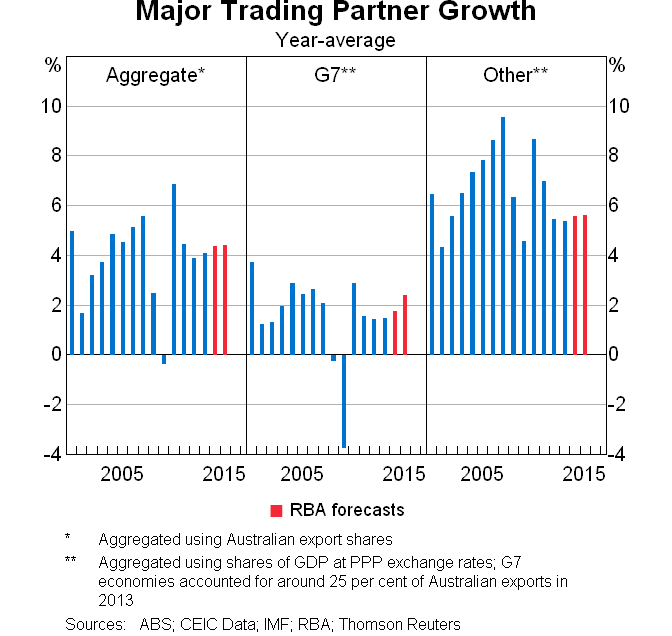
However, conditions in the major advanced economies are very important to Australia in other ways, via their effects on global financial conditions and through indirect trade linkages.[3]
The economies of the United States, Japan and the euro area are in different phases of the business cycle; however, inflation is low and monetary policies remain very stimulatory in all. Stimulatory monetary conditions in those economies, including the exceptional expansion of their central bank balance sheets, has led to very low levels of interest rates globally and has contributed to a global ‘search for yield’, with important implications for exchange rates.
After the recession following the global financial crisis, the recovery of the US economy is now well established. There has been a sizeable decline in the unemployment rate while wage growth and the rate of inflation have picked up a little of late (Graph 2). The Federal Reserve has now ended the extraordinary expansion of its balance sheet and markets are focused on the question of when the Fed might begin the process of raising its policy rate. This is generally anticipated to be sometime around the middle of next year. Once that process is seen to be starting in earnest (or at least much closer to starting), it may well lead to a further appreciation of the US dollar. The flipside of this would be a further depreciation of the Australian dollar, which remains above most estimates of its fundamental value, particularly given the substantial declines in commodity prices over the course of this year.
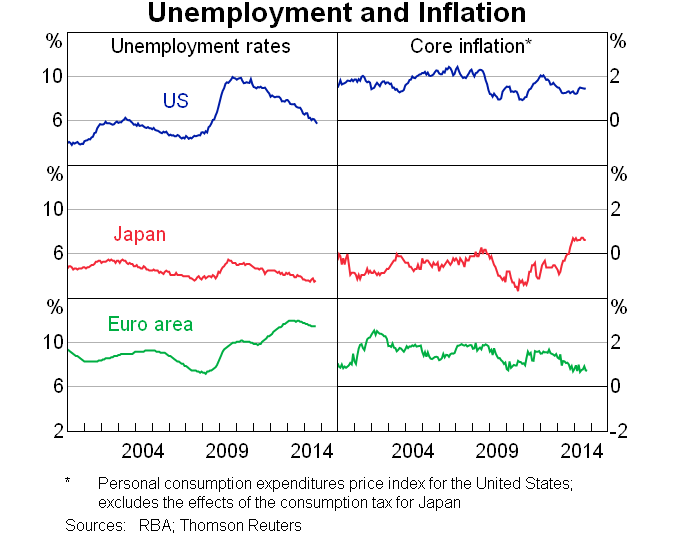
Unfortunately, the prospect of even the beginning of the normalisation of financial conditions is a distant one for both Japan and the euro area.
Japan has made some progress over the past year or more in lifting GDP growth and inflation, and the labour market there is as tight as it has been in 15 years (based on the unemployment rate). However, growth of economic activity looks to have been rather subdued since earlier this year, wage growth is still very low (though edging higher), and consumer price inflation remains some way from the Bank of Japan's 2 per cent target. Given that state of affairs, the Bank of Japan recently announced a significant expansion of its quantitative easing program.
Meanwhile, the euro area is still close to the low point in its business cycle. Overall, growth of economic activity is modest at best. The unemployment rate has declined a little but it remains at a very high level. Inflation and inflation expectations have both declined over the course of this year to quite low levels, leading the European Central Bank to ease monetary policy further.
In short, Australia's major trading partner growth has been close to average and is likely to be around average, possibly even a touch higher, for the next two years. The major advanced economies are at different stages in the business cycle, but all still have very stimulatory monetary policies, which is keeping interest rates low globally. One consequence of the exceptional expansion of the central bank balance sheets of the major advanced economies is that the value of their currencies has been lower than would otherwise have been the case. Conditions in the advanced economies will be important for the Australian economy via global financial market conditions and exchange rates.
State of the Australian Economy
How should we characterise the state of the Australian business cycle? The less extreme case I described at the outset is the relevant one. That is, the unemployment rate has risen gradually over the past couple of years to a level that is high relative to its recent history (Graph 3). That is consistent with below-trend growth of economic activity over that period. Growth over this financial year is likely to remain below trend, but our forecast is for growth to pick-up gradually to an above-trend pace by 2016. There are already signs of better growth in some parts of the non-mining economy, supported by the very low level of interest rates.
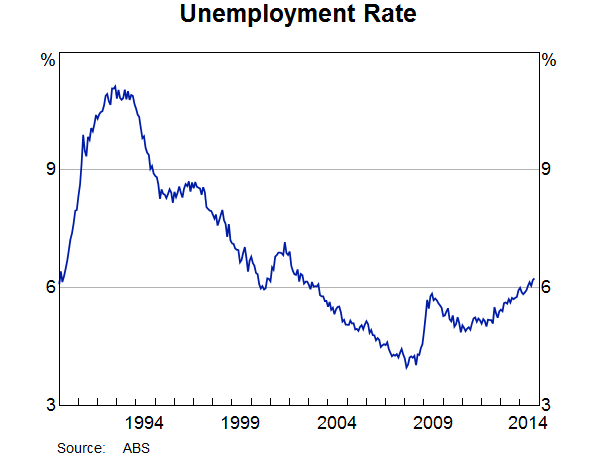
Measures of aggregate activity
When measuring economic activity, a lot of attention is paid to aggregate GDP. That's appropriate given that it is a comprehensive measure of activity from the national accounts.
The June quarter national accounts recorded an increase in GDP growth over the past financial year to a pace that was actually close to trend (in year-ended terms; Graph 4). Moreover, this pace was a bit stronger than we had forecast a year ago.
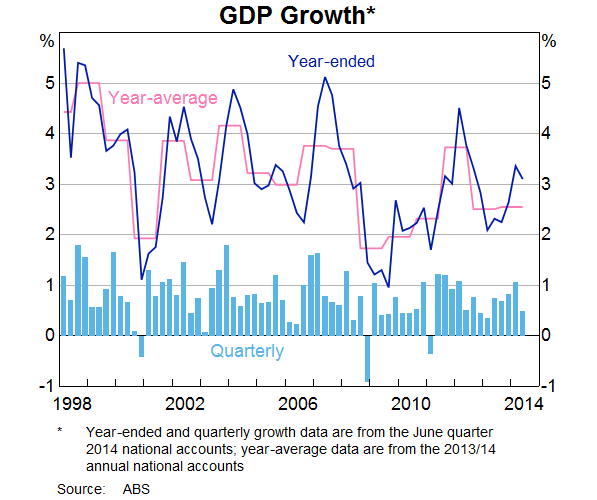
However, the recently released annual national accounts data incorporated a downward revision to GDP growth, to 2.5 per cent in year-average terms for 2013/14. This was the same rate as the year earlier; it was a bit below trend and it was in line with our forecasts of a year ago.[4] The source of this downward revision was less growth of export volumes than earlier estimated, although export growth still remained strong.[5]
Looking at more recent quarters, our assessment of a broad range of timely indicators of activity is that the moderate pace of growth recorded in the June quarter (0.5 per cent according to the quarterly national accounts) has been maintained over recent months.
Pulling this all together suggests that growth has been below trend for the past two years or more.
Measures of mining and non-mining activity
Underlying the pattern of growth of aggregate economic activity, there have been some important differences across the mining and non-mining sectors. These differences are relevant to understanding the current state of the business cycle and the prospects for growth.
As is well known, the economy is in the midst of the transition from the investment phase to the production phase of the resources boom. Mining investment has been declining for about two years now. At the same time, exports of resources have risen significantly as investment projects reach completion. Further rises in export volumes are in prospect, particularly as liquefied natural gas (LNG) projects begin to ramp up production. However, because the production phase of the boom needs much less labour than the investment phase, this transition is freeing up labour from resource and resource-related activities. Given this, it makes sense to consider GDP growth excluding resource exports. This has picked up over 2013/14 (Graph 5). Nonetheless, it remains below its historical average. In large part, this reflects the decline in mining investment. And by our estimation, mining investment is set to decline more rapidly in the coming year or so than it has since it peaked in mid 2012.
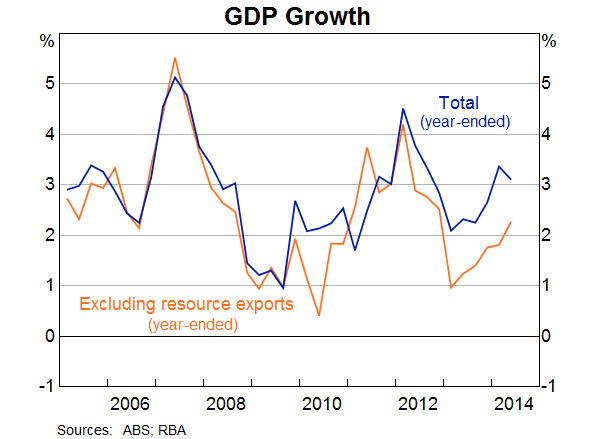
It also makes sense then to look at non-mining activity. This can be approximated as GDP excluding both resource exports and mining investment (net of imports).[6] Growth of this narrower measure of activity has increased over the past year and is, therefore, helping to offset the fall in mining investment, including by absorbing labour being freed up from the resources sector (Graph 6). Growth of non-mining activity is actually not that far from its historical average. Much of this improvement can be attributed to the very low level of interest rates.[7] The effect of this is perhaps most evident in the strength of housing market conditions, which are supporting strong growth of dwelling investment.
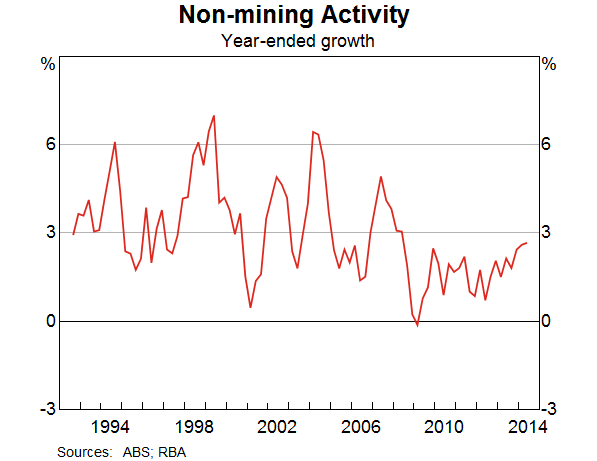
Low interest rates, and higher housing prices, have also lent support to the growth of consumption, which has picked up over the past year or so, notwithstanding the weak growth of incomes. The strength of this effect is most apparent in those states for which housing market conditions have been strongest, namely New South Wales and, to a lesser extent, Victoria (Graph 7). These states are also less exposed to the effect of declining mining investment and commodity prices, which are weighing more heavily on Queensland and Western Australia.
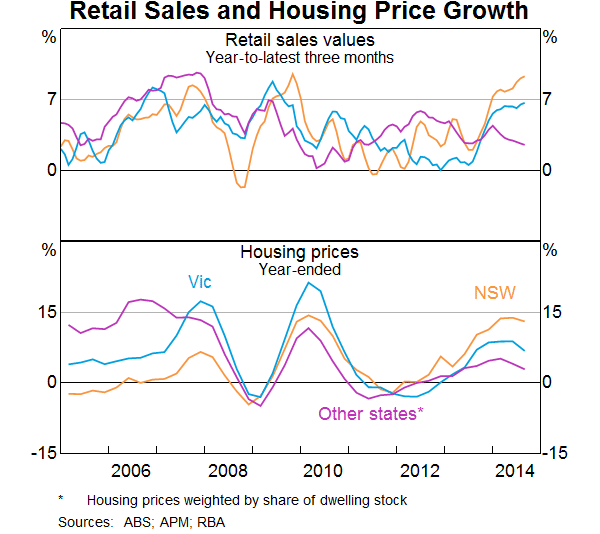
Meanwhile, non-mining business investment, after picking up following the global financial crisis, has been little changed now for three years. It remains very low as a share of nominal GDP. So the need for a recovery there is clear.
To recap, various measures suggest that growth of aggregate economic activity has been a bit below trend for the past couple of years, consistent with the gradual rise in the unemployment rate over that period. Much of the growth of activity over the past year owes to the production and export of resources, which uses labour less intensively than other sectors of the economy. Even so, growth of non-mining activity looks to have picked up.
The Outlook for Australia's Economy
So, what are the prospects for growth of activity and labour market conditions?
Our expectation is that growth will continue to be a bit below trend for a time, picking up gradually to be a bit above trend pace by 2016. And the unemployment rate is likely to remain elevated for some time.
The near-term weakness reflects a combination of three forces: a sharper decline in mining investment over the coming quarters than seen to date; the effects of the still high level of the exchange rate; and ongoing fiscal consolidation at state and federal levels. In contrast, resource exports are likely to make a further strong contribution to growth, with LNG exports expected to begin ramping up over coming quarters. At the same time, very low interest rates are working to support growth of household expenditure. In time, growth of household demand and the impetus to domestic demand provided by the exchange rate depreciation we have seen since early 2013 are expected to spur non-mining business investment.
Given this outlook, I want to touch on two relevant aspects of the business cycle that are important sources of uncertainty for our forecasts. One is related to household consumption, the other to business investment.
Household consumption
At this phase in the business cycle, it's natural to worry about the possibility that consumption will be weighed down by slow growth in household incomes, driven in turn by the subdued state of the labour market. It is true that stronger growth of employment and wages would provide more support for consumption. However, that dynamic usually kicks in later in the cycle. In the meantime, it's reasonable to expect that very low rates of interest will enable and encourage households to shift some expenditure from the future to now, including via higher asset prices. This would see a decline in the share of disposable income that households save (i.e. a lower saving ratio). There are limits to this, and it would be unwise to build a recovery on a foundation of a sharp decline in the saving ratio.
Our latest forecasts, however, suggest that there will be a gradual decline in the saving ratio over the next couple of years, of the same order of magnitude as we've already seen over the past couple of years.
A decline in the household saving ratio would be consistent with the tendency for labour market developments to lag developments in economic activity, including consumption, by a few quarters. Consumption and GDP growth tend to pick up ahead of an improvement in employment growth, which would in turn be expected to occur before we see wage growth start to return to more normal levels. This was the case during the recessionary episodes of the early 1990s and following the global financial crisis (Graph 8).
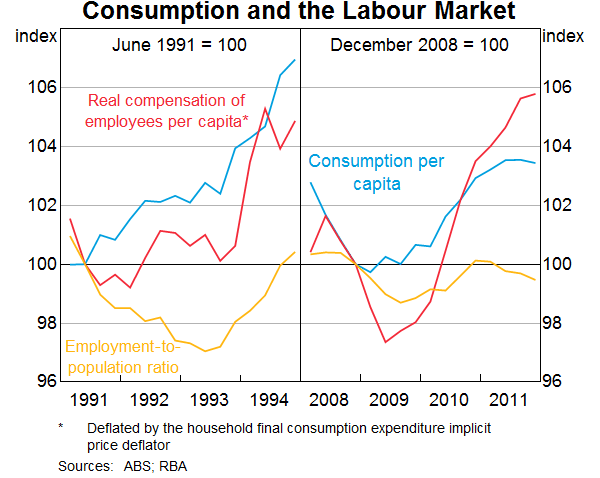
Non-mining business investment
I've spoken at length recently about the factors that might have led to subdued non-mining business investment over recent years.[8]
In short, I concluded that this outcome had been consistent with a period of greater uncertainty and below-average confidence. Both of these have changed for the better more recently, yet firms still seem reluctant to take on risks associated with substantial new investment projects. If the appetite of businesses (and shareholders) for risk were to improve, investment could pick up. It's hard to know when such a turning point in spirits might take place. But it is more likely when the fundamental determinants of investment are in place as they seem to be now. The ready availability of internal and external finance, at very low cost, is one such element of that. Also, there is the stronger growth of demand across the non-mining parts of the economy over the past year or so and measures of capacity utilisation have increased to around long-run average levels. So there is a reasonable prospect of business investment picking up, in time.
Even so, let me note some reasons why the anticipated recovery in non-mining business investment might not be quite as strong as in earlier episodes. But I will stress at the outset that if that comes to pass, it does not mean that growth of activity or of our prosperity need suffer.
One reason why investment in the non-mining sector might be lower than in the past is that service industries account for an increasing share of our economy – rising by about 12 percentage points in terms of the employment share over the past three decades. This is relevant to investment because service industries, on average, have much lower levels of capital relative to labour (Graph 9). So, in an economy in which services account for a higher share of economic activity, other things equal, the optimal (non-mining) capital stock should be lower than it otherwise would be (as a share of that economy).[9] However, that doesn't imply that GDP growth will be lower, nor does it suggest that the economy will be a less prosperous one. What matters for these things is whether we are taking advantage of profitable opportunities and using labour and capital in the most productive ways that we can. Also, it is worth emphasising that many services require high levels of human capital – in the form of education and training – which does not get picked up in investment as measured by the national accounts.
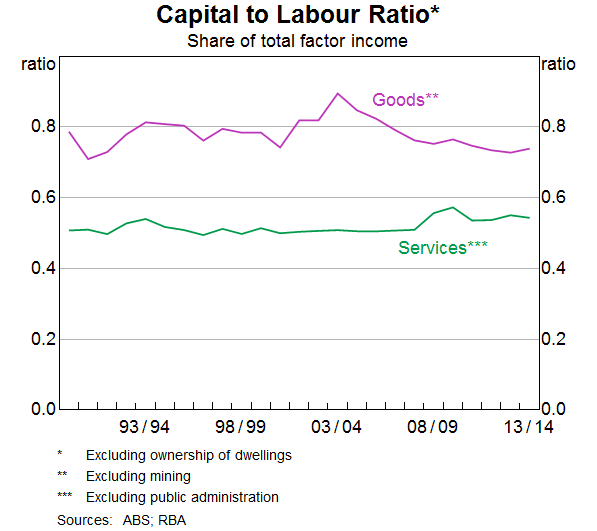
Investment today might also be lower (as a share of nominal GDP) than in the past for another reason. Over time there has been a sizeable decline in the price of many types of machinery and equipment (particularly those related to information and communications). So, businesses are able to spend less to obtain a given level of capital services. For example, they can purchase a lot more computing power for a given level of nominal spending. Once again, if this leads to lower investment (as a share of nominal GDP) than in the past it does not imply less output growth or lower prosperity. Indeed, given that Australia imports much of our machinery and equipment, a lower price of that capital is to our benefit.
Conclusions
The major advanced economies are in different stages of the business cycle. The recovery from recession is well established in the United States, but has a long way to go in the euro area. Japan has made some progress in reducing the extent of spare productive capacity, but inflation is still some way from the Bank of Japan's target. Nevertheless, growth of Australia's major trading partners has actually been around average for some time now and, as best we can tell, it is likely to remain at that rate in the year ahead.
Australian GDP growth has been a bit below trend pace over the past couple of years, consistent with a gradual rise in the unemployment rate. Much of the growth this past year owed to rising resource exports, although growth outside the mining sector also picked up. However, with mining investment set to fall more sharply over coming quarters, GDP growth is expected to be below trend for a time before gradually picking up to an above-trend pace by 2016.
The very low level of interest rates is supporting, and will continue to support, growth of household expenditure. In time, this is expected to support a recovery in non-mining business investment, and the economy more broadly, including an improvement in conditions in the labour market. If history is any guide, the recovery is likely to proceed in that order, from household expenditure to business investment to labour market conditions. History also suggests that a pick-up in business investment (outside of the resources sector) will come, in time. The fundamental forces are in place to support that recovery. And while I have suggested some reasons why business investment might not be quite as strong as past episodes of recovery might suggest, these don't imply that the economy overall will be less strong than otherwise, but rather just one element of expenditure that we measure via the national accounts.
Endnotes
I thank Natasha Cassidy, Vanessa Crowe, Emma Doherty, Craig Evans and Thomas Mathews for help in preparing these remarks. [*]
See, for example, the November 2014 Statement on Monetary Policy. [1]
In 2013, the G7 economies accounted for about 25 per cent of Australia's exports directly, compared with about 40 per cent in 2000. And while Australia trades with these economies less than in the past, they still have an important bearing on global demand and supply conditions, thereby influencing the prices of our imports and exports. [2]
Kelly G and G La Cava (2014), ‘International Trade Costs, Global Supply Chains and Value-added Trade in Australia’, RBA Research Discussion Paper No 2014-07. [3]
Until the September quarter national accounts are released in early December, we won't know though what the revision to the annual figure implies for the quarterly pattern of growth. [4]
The downward revision to exports reflected shifting the reference year forward (to 2012/13). Given the decline in commodity prices, this has the effect of reducing slightly the contribution of resources exports to growth. [5]
This requires an estimate of imports used in mining investment. This is a rather imprecise exercise and so the estimates for non-mining activity should be considered as rough. [6]
The low growth of non-mining activity seen over the second half of the 2000s was not a sign of weakness in the economy overall, at least prior to the global financial crisis. Rather, the economy was growing strongly – as evidenced by the declining unemployment rate – with slower growth of non-mining activity offset by rising mining activity, particularly mining investment. [7]
Kent, C (2014), ‘Non-mining Business Investment – Where to from here?’, Address to the Bloomberg Economic Summit, Sydney, 16 September. [8]
This is not to say that there hasn't been a deepening in capital over time – that is, more capital per worker in both goods and services sectors. Rather, for a given increase in the number of workers, we need less investment just to keep the capital-to-labour ratio constant if a greater share of those workers are in the services sector than in the past. [9]